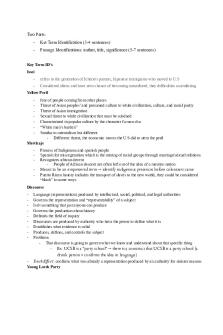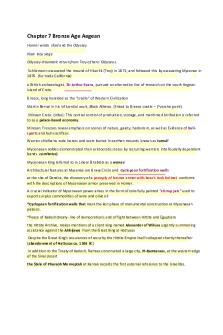DNY Midterm Paper- Professor Nicole McGovern PDF

| Title | DNY Midterm Paper- Professor Nicole McGovern |
|---|---|
| Course | Core: Discover New York |
| Institution | St. John's University |
| Pages | 4 |
| File Size | 65.3 KB |
| File Type | |
| Total Downloads | 74 |
| Total Views | 146 |
Summary
Discover New York (DNY) midterm essay for Professor Nicole McGovern. Received an A on it....
Description
10/10/18 Professor McGovern
Arab Immigrants Post-9/11
The attacks that occurred on September 11, 2001 forever changed the way those from Saudi Arabia were viewed by Americans. Now all Arabs would be the target of Americans’ distrust, hatred, and fear due to how members of Islamic extremist group Al-Qaeda flew planes into the World Trade Center in NYC and into the Pentagon outside of Washington, D.C. These negative feelings were especially prevalent in New Yorkers, seeing that their state was the main target of these attacks, and as a result made the lives of the Arabs that were trying to immigrate to New York miserable. In addition to the struggle of leaving old homes and communities behind to pursue opportunity in a completely foreign land, Arab immigrants suffered from restricted economic opportunities as a result of workplace discrimination, as well as major social injustices. Sadly, many are continuing to suffer today with each new terror attack committed by a small amount of extremists in the supposed name of Islam. Like many other immigrant groups, Arabs came to New York seeking a better life than they had. They found the many economic opportunities New York offered to be attractive and were eager to partake in them. Fortunately, they were not escaping any civil strife in their homeland, which cannot be said about many other immigrant groups that came to the United States, such as the Irish. However, when they immigrated to America, they were the target of much hatred and social injustice. The article “Hate Crimes Against American Muslims Most Since Post-9/11 Era” by the New York Times talks about hate crimes against Arab-Americans
went up to their highest levels after the September 11, 2001 attacks, some of which included “arsons at mosques, assaults, shootings, and threats of violence” (Lichtblau, 2016). So instead of being threatened and attacked for their beliefs back in Saudi Arabia, they were threatened and attacked here in the United States, the place they came for a better life. What made many of these Arabs particularly vulnerable to attacks were their religious garments, such as headscarves and face coverings for women, and skull caps for men. An article by The Guardian tells the story of Adama Bah, a sixteen-year-old girl in Manhattan who at that time wore a face veil. The FBI and the police broke into her house, handcuffed her and her dad, put them in jail cells, and told her she “had to be strip-searched” for she “no longer had rights” (Malek, 2011), according to the female guard, who then instructed her to lift her breasts and open her legs. This is just one of the many horrifying examples of social injustices Arab immigrants faced after 9/11 in a so-called effort by the United States to protect its security. Social issues were not the only issues Arab immigrants faced when they came to this country. They also faced economic issues caused in part by workplace discrimination. According to the article “Muslims Report Rising Discrimination at Work” by the New York Times, Muslims are complaining about everything from “co-workers calling them ‘terrorist’ or ‘Osama’” (Greenhouse, 2010) to employers banning them from taking prayer breaks or wearing headscarves. Unsurprisingly, many of these complaints came from Muslims in New York, with them filing a record number of claims in the Islamic Center in Lower Manhattan in the period immediately after 9/11. These claims were “up 20 percent from the previous year” (Greenhouse,
2010), according to the article, which then goes on to describe several eye-opening stories of workplace discrimination faced by Muslims, specifically Arab Muslims. One talks of how a meatpacking company threw meat and bones as well as cursed at the Arab immigrants that worked there; another talks of how an Arab immigrant working at a Four Points by Sheraton hotel in New York was called a “camel jockey” and was “mocked with Arab ululations and taunted about news items about captured terrorists” (Greenhouse, 2010). These stories prove how the discrimination Arab Muslim immigrants face carry over into the workplace, thus potentially limiting their ability to perform at their job or reducing the amount of opportunities they have in friendlier, safer environments. Furthermore, they point to the unfortunate common thread between the economic stories of immigrants: that despite coming to America in search of a better life, for a while most immigrants wind up being in the same economic conditions they were in in the country they came from. Clearly, Arab immigrants in the United States, specifically in New York, face unique economic and social challenges due to the tragic events that occurred by a handful of people from their race. And while they continue to face these challenges today due to more of the actions of a few members of their race or religion, there has also been a surge in level of awareness and acceptance towards the plight of historically disadvantaged groups in recent years, from the LGBTQ community to women to Muslims, so I am hopeful that more and more people show their love and support for these Arab immigrants, and recognize the important distinction between the vast majority of their race and the actions of a few extremists.
Works Cited Greenhouse, Steven. (2010, September 23). Muslims report rising discrimination at work. Retrieved from https://www.nytimes.com/2010/09/24/business/24muslim.html. Lichtblau, Eric. (2016, September 17). Hate crimes against American muslims most since post-9/11 era. Retrieved from https://www.nytimes.com/2016/09/18/us/politics/hate-crimes-american-muslims-rise.htm l. Malek, Alia. (2011, September 11). After 9/11: ‘you no longer have rights’ - extract. Retrieved from https://www.theguardian.com/world/2011/sep/02/after-9-11-muslim-arab-american-storie s....
Similar Free PDFs

Dny asl paper - Grade: B
- 6 Pages

Riassunti paper professor Cucco
- 15 Pages

Theory paper - Professor Kresse
- 2 Pages

Midterm Paper - ESC1200ID
- 6 Pages

Midterm paper - Grade: A
- 7 Pages

ENGL 50 Midterm - Professor Black
- 10 Pages

Chapitre 1 - Nicole Azoulay
- 33 Pages

Midterm Paper HRM 101 HRM
- 5 Pages

FTV Midterm Paper - Grade: B
- 6 Pages
Popular Institutions
- Tinajero National High School - Annex
- Politeknik Caltex Riau
- Yokohama City University
- SGT University
- University of Al-Qadisiyah
- Divine Word College of Vigan
- Techniek College Rotterdam
- Universidade de Santiago
- Universiti Teknologi MARA Cawangan Johor Kampus Pasir Gudang
- Poltekkes Kemenkes Yogyakarta
- Baguio City National High School
- Colegio san marcos
- preparatoria uno
- Centro de Bachillerato Tecnológico Industrial y de Servicios No. 107
- Dalian Maritime University
- Quang Trung Secondary School
- Colegio Tecnológico en Informática
- Corporación Regional de Educación Superior
- Grupo CEDVA
- Dar Al Uloom University
- Centro de Estudios Preuniversitarios de la Universidad Nacional de Ingeniería
- 上智大学
- Aakash International School, Nuna Majara
- San Felipe Neri Catholic School
- Kang Chiao International School - New Taipei City
- Misamis Occidental National High School
- Institución Educativa Escuela Normal Juan Ladrilleros
- Kolehiyo ng Pantukan
- Batanes State College
- Instituto Continental
- Sekolah Menengah Kejuruan Kesehatan Kaltara (Tarakan)
- Colegio de La Inmaculada Concepcion - Cebu






